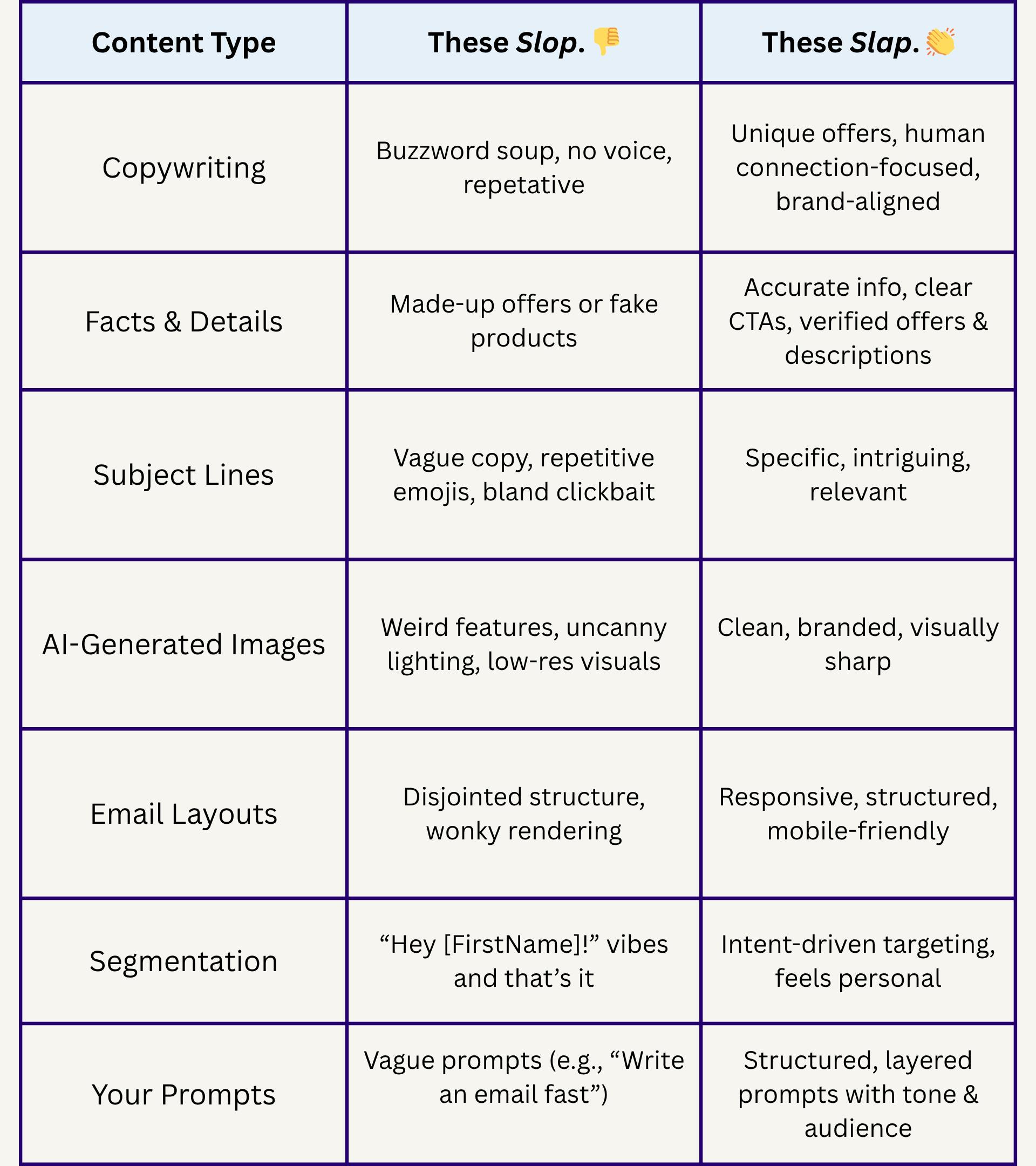Have you ever seen the official Dog Olympic Diving competition? How about Golden Retrievers organizing themselves to spell out the names of Greek gods? Or an “It’s my 120th birthday” post? Shrimp Jesus?
This fake, inauthentic, sometimes silly and often annoying type of content is called AI Slop. And whether we like it or not, the internet is certainly in its AI Slop Era.
The slop doesn’t just end with social media and the ubiquitous Facebook AI slop though. Your inbox, your posts, your blog—and perhaps even emails you send—are at risk of hosting finger-mangled images, hallucinated text, bogus facts and copy that sounds like it was ghostwritten by a blender.

Despite what Pat thinks, this didn’t take any great talent to produce.
While it is fun to chuckle at the people who fall for this type of content when it’s clearly fake, AI slop can be pretty lethal for brands that are trying to build trust while keeping their followers and subscribers genuinely engaged. Of course, as the talented marketer you are, you surely won’t include any of the aforementioned AI slop in your work . . . However, you may need a little guidance on how to decide what the best AI for marketing tools and approaches are, so your emails don’t start to venture into slightly sloppy territory.
Here’s our guide on how to spot AI slop, how to fix it and how to choose AI email marketing tools that don’t make your campaigns sound generic.
What Is AI Slop? And Is It In My Emails?
AI slop is a term for low-quality media, including writing and images, made using generative artificial intelligence technology, characterized by an inherent lack of effort, logic or purpose. At its worst, it’s mass-produced, shallow, inaccurate and a cheap effort at engagement farming. Interestingly, John Oliver did a deep dive into AI Slop on the most recent episode of Last Week Tonight, as it’s taken over some corners of the internet.
If you have a half hour to spare, this is pretty funny . . . and disconcerting.
In regards to marketing content, AI slop goes beyond the simple trope of people with too many fingers. While social media-focused AI-generated images and videos are sometimes crafted to sow discord, bad email examples of AI slop include things like:
- Email subject lines that feel generic at best . . . and like a spammy Mad Libs game at worst
- Hallucinatied copy with fake discounts, incorrect product names or gibberish
- Broken layouts that that render differently on Gmail, Apple Mail and Outlook
- Images with unbranded styles, off-putting lighting or plain old weird vibes
Sloppy emails are what happen when you use general-purpose AI tools with vague prompts, rather than using the right AI email marketing tools that actually deliver personalized, high-performing campaigns. The right AI tools will help you scale your brand, not embarrass it.
The AI Slop Checklist: Bad Email Examples vs. Good Email Examples
Using AI for email marketing is essential. Making the right choices in tools to use—and using them effectively—is essential as well. This comes at a time when 90% of consumers report higher satisfaction emails personalized by AI. Meanwhile, AI-powered email marketing increases open rates by an average of 28% and click-through rates by 23%. You simply can’t not use the technology!
To help you assess your potential AI email marketing tools and their outputs, reference our rubric below. Use it to quickly assess your content and protect your brand against AI slop:

What's slop? What slaps? This is the definitive list for email marketers.
There’s no objective rule on judging AI slop, but our advice is this: If you’re seeing 3 or more of these Bad Email Example signs in your campaign, it’s time for an AI detox.
We suggest taking a step back and examining how you can make your email content more authentic, customer-focused and on-brand. If you need a little extra help, the Prompt Pyramid method is a great place to start refreshing your marketing content with details that’ll be better suited for your subscribers.

Starting with thorough, descriptive prompts will make a huge difference.
You can learn more about this prompting method and other marketing toolkit essentials AI experts swear by right here.
Why Does AI Slop Happen . . . Even in Email Marketing?
Many AI tools used for marketing aren’t purpose-built for email marketing. This means that:
- They’re trained on general data that’s scraped from the web, instead of vertical and consumer specific datasets.
- They don’t understand your brand, your products or your customer journeys.
- They spit out content quickly, but it’s not tuned to who you are, what you’re selling and what your subscribers will engage with.
Sure, tools like ChatGPT and Perplexity are incredible resources that can help you generate everything from subject lines to body copy. However, they aren’t trained on the data that drives engagement and sales for your exact brand. Compared to AI email marketing tools that are trained on the right data and customer insights, their outputs will feel . . . somewhat sloppy.
How The Best AI for Marketing Tools Help You Stay Slop-Free
So what sets great AI email marketing tools apart from their counterparts?
- Their models are trained on real marketing data from your industry that’s refreshed, groomed and maintained.
- Your brand voice baked into your AI copywriting, from tone, styles, offers and ways of structuring content. Basically, your sends just sound like you.
- The best AI marketing tools are built for marketers’ ease of use with UX, tools and templates that are ready-to-go.
- And they’re segment-driven, personalizing content that actually hits, instead of simply including merge tags.
Watch a demo where Backstroke generates campaigns in minutes with data-driven creative and 75+ templates.
Backstroke Doesn’t Do Slop.
Backstroke is the best AI for email marketing teams who want:
- Campaigns built on real DTC and email performance data from 12,000+ brands
- Predictive segmentation and rendering, so your design and copy are on point
- Brand-safe content every time, with 75+ polished templates to match
- A comprehensive tech stack to cover your AI email marketing to-do’s: copywriting, image design, segmentation, email layouts and more
With the right prompts, AI tools and data, you can say goodbye to the threat of AI slop encroaching on your email marketing—from hallucinations, to wonky fingers, to downright boring subject lines—and hello to smarter, sharper, revenue-driving campaigns.
Want to see what great AI looks like?